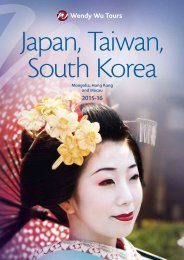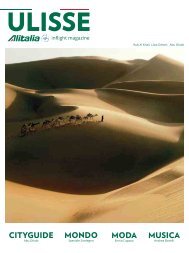Create successful ePaper yourself
Turn your PDF publications into a flip-book with our unique Google optimized e-Paper software.
KNOW INTERVISTA<br />
RICHARD GEOFFROY<br />
L’arte di essere effervescente.<br />
di Fabiana Giacomotti<br />
Una breve digressione storico-temporale, utile a definire<br />
la personalità di Richard Geoffroy, chef de cave di Dom<br />
Pérignon. Circa quindici anni fa, un ristrettissimo gruppo<br />
di giornalisti venne invitato a seguire questo signore<br />
dinoccolato e ipercinetico in un viaggio in Giappone che, secondo<br />
gli scopi dichiarati, intendeva esplorare i punti di contatto fra le<br />
ultime cuvée e la cucina tradizionale nipponica, in special modo<br />
quella dei monasteri. Un esperimento che combinava uvaggi pregiati<br />
e fondi di fiori di loto, per dirla in sintesi. Abbastanza eccentrico<br />
perché gli invitati, tutte vecchie volpi e del giornalismo e della<br />
critica enologica, intraprendessero quel viaggio fra Kyoto e i suoi<br />
dintorni montani con curiosità ma soprattutto una buona dose di<br />
scetticismo. Quindici anni dopo, le vecchie volpi ancora si ritrovano<br />
per parlare di una cena fra vassoi decorati con aceri rossi bonsai<br />
in uno dei ristoranti kaiseki più antichi dell’isola, e dell’entusiastico<br />
assenso di certi anzianissimi monaci per quel vino frizzante che,<br />
forse, non avranno sorseggiato mai più, in un romitaggio remoto<br />
fra le montagne. Si parlò molto poco, durante quelle cene, vuoi per<br />
la mancanza di una lingua comune, vuoi per le curiose sensazioni<br />
olfattive, di gusto, perfino tattili, provocate da quel matrimonio fra<br />
culture, religioni, filosofie di vita e, naturalmente, cucina, che nulla<br />
aveva di bislacco e molto da insegnarci. Alla base di tutto, lo intuimmo<br />
dopo, vi era uno sconfinato amore per la terra, la ‘buona<br />
terra’, per dirla con le parole di Pearl Buck, una scrittrice americana<br />
che aveva soggiornato a lungo in Estremo Oriente fra gli Anni 30<br />
e 40, e per quel che può riservarci quando la rispettiamo seguendone<br />
ritmi e possibilità. Era la ragione per la quale delle semplici<br />
rape al vapore ci sembrarono frutti del paradiso nel momento in cui<br />
incrociarono lo Chardonnay e il Pinot di Epernay e perché quelle<br />
poche ore trascorse inginocchiati sui tatami ci si sono inscritte nella<br />
memoria, e nel cuore, più delle centinaia di cene sontuose a cui<br />
abbiamo partecipato da allora per piacere, per dovere o per noia.<br />
All’epoca, Richard Geoffroy occupava quella carica già da dieci<br />
anni, ma pochissimi, tranne i più esperti, lo avevano incontrato.<br />
Non è un uomo che si faccia notare, che si metta in mostra: per coglierne<br />
la costante tensione, la curiosità febbrile, bisogna osservarlo<br />
The art of effervescence.<br />
A brief historical digression helps to define the personality of Richard<br />
Geoffroy, chef de cave of Dom Pérignon. About fifteen years ago,<br />
a small group of journalists was invited to follow this hyperkinetic,<br />
slouching gentleman on a trip to Japan. The stated purpose was to<br />
explore points of contact between the latest cuvée and traditional<br />
Japanese cuisine, especially that of the monasteries. In a nutshell,<br />
fine grapes and blends of lotus flowers. The experiment was quite eccentric<br />
because the guests, all old hands at journalism and wine criticism,<br />
embarked upon this journey between Kyoto and its mountain<br />
surroundings with curiosity, but also with a healthy dose of scepticism.<br />
Fifteen years later, the old hands still get together to talk about<br />
a dinner with trays decorated with red maple bonsai in one of the<br />
island’s oldest kaiseki restaurants, and the enthusiastic response of<br />
certain elderly monks for that sparkling wine that, perhaps, they had<br />
never tasted, in a remote hermitage in the mountains. There was very<br />
little conversation during those dinners, either for lack of a common<br />
language, or for the curious sensations of smell, taste - even touch -<br />
caused by the <strong>mar</strong>riage between cultures, religions, philosophies of<br />
life and, of course, cuisine, which had nothing odd and a lot to teach.<br />
Behind it all, we understood later, was a boundless love for the land,<br />
the “good earth” to quote Pearl Buck, an American writer who spent<br />
much time in the Far East in the 1930s and ‘40s, and for what it may<br />
hold when we respect it by following its pace and possibilities. The<br />
simple steamed turnips seemed like fruits of paradise when combined<br />
with Chardonnay and Pinot Epernay, and those few hours spent<br />
kneeling on the mat inscribed in the memory, and in the heart, many<br />
hundreds of sumptuous dinners we have attended since then, for<br />
pleasure, duty or boredom. Richard Geoffroy had occupied that position<br />
for ten years, but very few, except for the more experienced, had<br />
met him. He is not a man who draws notice, or shows off: to grasp his<br />
constant tension and feverish curiosity, we must observe him for a few<br />
minutes as his hands move imperceptibly, or as he adjusts his glasses,<br />
or notes with interest and involvement an event that has nothing to<br />
do with the topic at hand. In that moment, he is “putting together”<br />
60 ULISSE MARZO 2015




